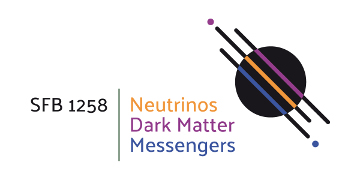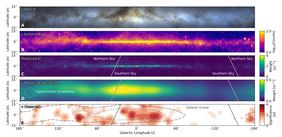The faint band of stars in the Milky Way, which glows at night in the night sky, has always impressed mankind, even if people have only started to understand the Milky Way as their home galaxy and to unravel its structure at the beginning of modern times. Now, the scientists of the IceCube Neutrino Observatory at the South Pole have succeeded for the first time in creating a neutrino image of the Milky Way.
Gamma-rays as an indication of neutrinos
From the observation of extremely high-energy light – the gamma radiation – from our home galaxy the researchers had long since concluded that the Milky Way must also be a source of neutrinos, because these are produced, together with gamma rays, when high-energy cosmic rays collide with the gas and dust between the stars.
Using the Earth as passive filter
However, the identification of the neutrinos was difficult: trillions of particles of different origins and energies rain down on the earth every second. In order to be able to distinguish background particles from the sought-after high-energy neutrinos coming from space, it was initially planned to use the earth as a passive filter when designing the IceCube Neutrino Telescope in the 2000s.
Introducing an active background filter in IceCube
"As a consequence, the Milky Way would have been excluded from IceCube's observation horizon," says Elisa Resconi, Professor for Experimental Physics with Cosmic Particles at the Technical University of Munich and spokesperson of the Collaborative Research Center 1258 (SFB1258). Only the development of an active background filter in 2009 with Stefan Schönert, Professor for Astroparticle Physics also at TUM, enabled the inclusion of the observation data of the southern hemisphere and thus of the Milky Way.
Machine learning methods led to success
"The difficult task then was to find the neutrinos of the Milky Way in the filtered data," explains Resconi, "because the neutrinos of the distant universe by far outshine those of our immediate cosmic environment." With advanced methods of machine learning, this has now been achieved after years of effort as part of a doctoral thesis at the TU Dortmund: From around 59,000 signals observed in the ten years since IceCube went into operation in 2011, up to 748 neutrino signals could be assigned to the Milky Way.
Further observation data is needed
"However, it is unclear whether this is a diffuse emission of neutrinos from the galactic plane or neutrinos from yet unresolved celestial objects in the Milky Way," says Resconi. "and without further observation data, this question cannot be answered either."
P-ONE: New neutrino telescope in the Pacific Ocean
Resconi has therefore recently launched an initiative to build a new detector for high-energy neutrinos, the Pacific Ocean Neutrino Telescope (P-ONE). Around 100 scientists from Canada, the USA, Poland and Germany now belong to the international P-ONE collaboration. Preparatory work for the first detector lines is on-going in the Pacific Ocean off the Canadian coast at a depth of 2600 meters.
A new window on our cosmic neighbourhood
P-ONE will contribute to solve the many questions that currently exist about the formation and origin of high-energy neutrinos from space - including the mystery of the neutrinos from the Milky Way. "But it is already clear that the first detection of high-energy neutrinos from the Milky Way with IceCube opens a completely new window for studying the most energetic particles in our cosmic environment, and represents a significant step towards understanding the origin of galactic cosmic rays," says Resconi.
About IceCube
The IceCube Neutrino Observatory monitors the cosmos from the depths of the South Pole ice. Encompassing one cubic kilometer of ice, the detector is equipped with 5,600 photosensors that capture the signals generated when cosmic neutrinos collide with ice molecules. The high-energy astronomical messengers provide information to probe the most violent astrophysical sources such as exploding stars, gamma-ray bursts and active galaxy nuclei. Approximately 300 physicists from 58 institutions in 14 countries make up the IceCube Collaboration.
Acknowledgement
The National Science Foundation (NSF), USA, provided the primary funding for the IceCube Neutrino Observatory, with assistance from funding agencies around the world. In Germany, IceCube is supported by the German Federal Ministry of Education and Research (BMBF), the Helmholtz Association, the German Research Foundation (DFG, Deutsche Forschungsgemeinschaft) through the Excellence Cluster ORIGINS and the Collaborative Research Centre 1258 (SFB1258), as well as by the participating universities.
Original publication
IceCube Collaboration: “Observation of high-energy neutrinos from the Galactic plane”
DOI: 10.1126/science.adc9818
Science, 29 June 2023
Contact
Technical University of Munich
School of Natural Sciences
Prof. Dr. Elisa Resconi
Chair for Experimental Physics with Cosmic Particles
E-Mail: elisa.resconi@tum.de
T: +49 89 289 12422



